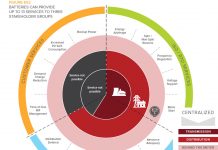John Petersen
Quarterly updates are among my least favorite tasks because they focus on where the energy storage sector has been instead of where it’s going. I still haven’t developed a presentation format I like, but it feels like things are heading in the right direction. Reader comments and suggestions on how I can make these updates more useful are always appreciated.
The 12-month performance for the energy storage sector was dismal and the only companies that currently trade above their September 30, 2009 closing prices are Active Power (ACPW) and Enersys (ENS). Most other companies in the sector are way down for the year. While softening markets for Exide Technologies (XIDE) and Axion Power (AXPW.OB) can be attributed to fund liquidations arising from the 2008 crash, most of the softness seems to arise from nagging uncertainty over what the future holds. A number of companies seem to have turned a corner during the third quarter, but sector performance in general can only be described as mixed.
The big winner for the quarter was Altair Nanotechnologies (ALTI), which was weak at June 30th but recently announced plans to sell a 51% interest to Canon Investment Holdings for $49.8 million and expand into China. The big loser was C&D Technologies (CHP), which was struggling at June 30th, recognized an intangible asset impairment $60 million in the quarter ended July 31st, and then negotiated an agreement in principle with certain noteholders that will convert $127 million of debt into equity and give the noteholders a 95% ownership stake.
The Altair and C&D transactions won’t close until the fourth quarter, but for purposes of this article I’ll treat both as done deals and work with rough pro forma estimates. I’ll also adjust the data for other companies as necessary to reflect financing transactions that have been reported since the date of their last quarterly reports.
The following table provides a quick summary view of stock price performance in the energy storage sector for the last twelve months and for the third quarter of 2010.

For the more visually inclined, the following graph tracks the composite price performance of my five categories of energy storage companies over the last year.

The history part is pretty straightforward. Now it’s time dust off the crystal ball and take a look at how things are shaping up for the next few months. Since my undergraduate degree was in accounting, the numbers are the first place I go when trying to discern the probable shape and size of future events. The following table provides summary data on a few financial metrics that I like to emphasize in any forward-looking analysis.

For companies with a history of losses, the first number I focus on is working capital. If a company can’t cover a year’s losses and make its planned capital investments with available funds, it will almost certainly be forced to seek new equity or debt financing and that can be very difficult in a turbulent capital market. The five companies that have clear working capital issues are identified with a red X in the working capital adequacy column.
A second key metric is the difference between a company’s market capitalization and its book value, which is commonly referred to as blue-sky. Public companies normally trade at a premium to their book value because intangible assets like proprietary technologies, human resources, industry experience, customer relationships and the like usually have no recognized balance sheet value. When the blue-sky premium is out of line on the high side, it’s a warning flag. When the blue-sky premium is out of line on the low side, it can hint at substantial upside potential. While peer group comparisons aren’t always reliable, they can provide useful guidance.
Many investors spend a lot of time obsessing over quarterly results, but I believe trailing twelve-month numbers provide a more reliable picture of how a company is performing because they smooth quarter-to-quarter changes in the business cycle and make it easier to spot companies that are performing better than their stock. Since its last quarter was disappointing but the company is solidly profitable on a trailing twelve month basis, I believe Exide Technologies (XIDE) will be a surprisingly strong performer over the next nine months.
The next twelve months will be turbulent times in the energy storage sector as manufacturers introduce a variety of transportation products and ramp up demonstrations of large-scale stationary storage products. I expect good things from Axion Power (AXPW.OB) as its PbC technology advances from successful laboratory testing with automakers to on-road fleet testing in stop-start systems. While it’s a decidedly unpopular position, I think cars with plugs will have a hard time meeting lofty market expectations. If the initial product introductions are not a smashing success, companies that make lithium-ion batteries could falter. While their working capital values are terrible, Beacon Power (BCON) and ZBB Energy (ZBB) seem to have more upside potential than downside risk and may be good speculations at current prices.
While my experience and personal investing preferences are in the lead-acid subsector, one could make strong to compelling arguments about the investment merit of each company I track. The challenges facing some are daunting, but the potential markets for their products are enormous. The information technology revolution was typified by a series of technologies that dominated the market then faded to obscurity. The cleantech revolution in general and the storage sector in particular will be very different because the best any company can hope for is a technology that will dominate a substantial market niche. In information technology, investing was like the hunt for the great white whale. In cleantech, it will be more akin to hunting in a herd of elephants.
The last year has been has been very tough on the energy storage sector, which is down 40% while the broader market indices are up 10%. The sector seems to be turning a corner as the shape of events over the next couple years become more obvious. Once the corner is turned, I expect the sector to outperform the broader market and become a mega-trend that will endure for decades. The sector is on sale for now but it won’t be for long.

Disclosure: Author is a former director of Axion Power International (AXPW.OB) and holds a substantial long position in its common stock.








My question is for John or any other blogger on here who can help.
What do you recommend to someone holding onto C & D Technologies stock now? Is there any chance it’ll recover down the road?
They’ve recently filed a registration statement and a proxy statement for a restructuring that will convert all the debt to common stock at an effective price in the $0.25 per share range. If that happens the price should recover into the mid-30s post restructuring, if not more. I’d be reluctant to sell C&D right now because it looks too likely to have a bit of a turnaround. It won’t be spectacular numbers, but even 100% up from the current levels would look pretty good.
Thanks for answering my previous question, John. I have one more: if the 3 measures proposed by the Board of Directors pass, how do you think this’ll affect the price of C & D Technologies stock? And is there any chance it’ll ever recover to its original price from earlier in the year before the steep drop (even if it takes a few years to do so)? Or would it be better to wait for it to make a partial recovery and then purchase a different stock?
A price recovery into the $.30 to $.50 range should be relatively easy. Beyond about $.50 per share it gets very hard for the price to climb because of the massive number of shares outstanding and the certainty of a whopping reverse split in the 1 for 10 or even 1 for 20 range. I keep saying that this one is out of my depth and it’s very hard to predict what will happen. I also remember that there were a lot of buyers in the $0.25 range right after the restructuring announcement.
I’m glad all 3 measures passed on Monday. The share prices have already gone up a little bit (more so than they have in the past few months). So it looks like a partial recovery is at least possible now.